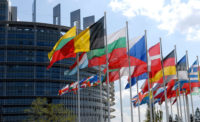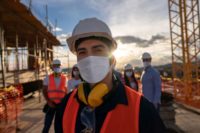The Human Cost of Occupational Illnesses and Injuries

It is often said that the U.S. and the U.K. are two nations divided by a common language. For example, Americans name the people who investigate occupational exposure and control methods industrial hygienists, whereas we Brits use occupational hygienists. But where noise is concerned, we definitely have agreement on the causal relationship between exposure and hearing loss, which has been observed anecdotally for centuries.
What is now referred to in an occupational context as noise induced hearing loss (NIHL) was observed in the early 1700s among copper workers in Italy. Later, towards the end of the 19th century, around the time of the first Industrial Revolution, Thomas Barr, a Scottish MD, coined the term Boilermaker’s ear after the first patients he observed (shipbuilders located on the River Clyde) who demonstrated the peculiar symptoms of impaired hearing. It’s easy to imagine the din caused by the impact of metal-on-metal when riveting.
So it’s frustrating, to say the least, that in the 21st century, 22 million U.S. workers according to the Centers for Disease Control (CDC) are still exposed to hazardous noise levels and a further 9 million are exposed to ototoxic chemicals. Hearing loss has become one of the most common work-related illnesses in the U.S. and globally, with 16 percent of hearing loss attributed to occupational exposure. NIOSH estimates that $242 million is spent annually on workers’ compensation for hearing loss disability; in 2015, $1.5 million in penalties was levied on employers. Doesn’t that seem small change for what is a wholly preventable disease?
It’s said that if your ears literally bled then wider society may have a different attitude toward (occupational) deafness. Perhaps the public would then view hearing loss as equal to the more obvious loss of a limb or precious eyesight. The latter are examples of acute safety issues, whereas hearing loss is chronic in nature—that is, it can take years before the effects become obvious, by which time the damage is done and can’t be reversed. Surprisingly, more people have hearing loss than diabetes, cancer, or vision trouble in the U.S.
The Impact of NIHL
Quoting directly from a CDC blog by Elizabeth Masterson:
Hearing loss can have a profound impact on the quality of life. The effects begin small and progress as hearing loss worsens. For most individuals, it starts with others sounding like they are mumbling because some sounds cannot be heard well. The individual often has to ask others to repeat themselves, and this becomes frustrating for both parties. Both begin limiting the length and depth of conversations. As hearing loss progresses, it becomes increasingly difficult to hear others in the presence of background noise. Social gatherings and even dinner at a restaurant become isolating activities because of the inability to understand what people are saying and individuals can’t contribute to the conversation.
There are other effects, such as loss of enjoyment. Even a person with mild hearing loss has trouble hearing softer sounds, has difficulty differentiating between the softest sounds and the loudest sounds, and has more listening fatigue. To compensate for this loss of hearing sensitivity, people with hearing loss will need to “turn it up” whenever possible.
Safety can also be compromised. The sounds of a tea kettle, the warning beep as a fork lift backs up, and the engine of an oncoming car may be missed. There can be a general loss of situational awareness.
Not surprisingly, all of these challenges can affect a person’s mental health. Hearing loss is strongly associated with depression. Depressed people are also less likely to participate in activities with others, so the effects of hearing loss and depression compound and intensify isolation. Hearing loss is also associated with cognitive decline, which includes loss of memory and thinking skills. As people lose their ability to hear, they don’t use the hearing-related parts of their brains as much, and these parts start to break down. It is a case of “use it or lose it.”
The Cost
NIHL is just one consequence of occupational exposure that the industrial hygienist has to consider among a plethora of potential hazards such as toxic dusts and vapors, radiation, and vibration. Long-term exposure can lead to debilitating illnesses such as hand-arm syndrome in the case of vibration and occupational asthma and lung cancers from breathing “contaminated” air in the workplace, which could ultimately lead to premature death. Construction is very prone to multiple exposure types, and the rate of deaths from respiratory diseases significantly exceeds the rate of accidental deaths (by a factor of 100 in the U.K.).
Apart from the emotive human costs, the National Academy of Social Insurance (NASI) reported that, for 2009, employers spent $74 billion on workers’ compensation. This figure rose to $88 billion in 2013. In that same year, the U.S. Bureau of Labor Statistics reported that more than 3 million workers had a non-fatal occupational injury or illness. Worldwide, according to the International Labour Organization (ILO), Annually, 160 million people are affected by occupational injuries and illnesses, and 2 million people die, with costs that equate to nearly 4 percent of world GDP. That’s over $3 trillion U.S. dollars!
Further delving back into history, during the building of the Panama Canal nearly six thousand deaths were recorded from disease and accidents, which today you would think unacceptable. However, it is said that 7,000 construction workers will have died in Qatar by the time the first ball is kicked in the soccer World Cup in 2022. How many more will have had preventable exposures? By contrast, the building of the London 2012 Olympic Park was a significant landmark in infrastructure development since there were no deaths during construction and the provision of occupational hygiene (and health) services demonstrated a 7:1 return on investment. This project has become the benchmark for U.K. construction, and a similar approach has been implemented on other major infrastructure developments such as London’s Crossrail rail project and regeneration of the iconic Battersea Power Station on the banks of the River Thames.
Clearly, ill health and injury are bad for business, which is at last waking up to the fact that good health and safety is an investment, not a “blocker” to productivity. But while health and safety are referred to in the same breath, we have actually been shouting safety and whispering health, and this must change.
Looking for a reprint of this article?
From high-res PDFs to custom plaques, order your copy today!








